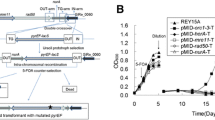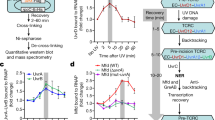Abstract
We previously isolated the RNC1/TRM2 gene and provided evidence that it encodes a protein with a possible role in DNA double strand break repair. RNC1 was independently re-isolated as the TRM2 gene encoding a methyl transferase involved in tRNA maturation. Here we show that Trm2p purified as a fusion protein displayed 5′ → 3′ exonuclease activity on double-strand (ds) DNA, and endonuclease activity on single-strand (ss) DNA, properties characteristic of previously isolated endo-exonucleases. A variant of Trm2p, Trm2p(ctΔ76aa) lacking 76 amino acids at the C-terminus retained nuclease activities but not the methyl transferase activity. Both the native and the variant exhibited sensitivity to the endo-exonuclease inhibitor pentamidine. The Saccharomyces cerevisiae trm2(Δ232-1920nt) mutant (containing only the first 231 nucleotides of the TRM2 gene) displayed low sensitivity to methyl methane sulfonate (MMS) and suppressed the MMS sensitivity of rad52 mutants in trm2(Δ232-1920nt)rad52 double mutants. The deletion of KU80, in trm2(Δ232-1920nt) mutant background displayed higher MMS sensitivity supporting the view of the possible role of Trm2p in a competing repair pathway separate from NHEJ. In addition, trm2 exo1 double mutants were synergistically more sensitive to MMS and ionizing radiation than either of the single mutant suggesting that TRM2 and EXO1 can functionally complement each other. However, the C-terminal portion, required for its methyl transferase activity was found not important for DNA repair. These results propose an important role for TRM2 in DNA repair with a potential involvement of its nuclease function in homologous recombination based repair of DNA DSBs.






Similar content being viewed by others
References
Haber JE (2000) Partners and pathways in repairing a double-strand break. Trends Genet 16:259–264
Johnson RD, Jasin M (2001) Double-strand-break-induced homologous recombination in mammalian cells. Biochem Soc Trans 29:196–201
Johnson RD, Jasin M (2000) Sister chromatid gene conversion is a prominent double-strand break repair pathway in mammalian cells. Embo J 19:3398–3407
Kanaar R, Hoeijmakers JH, van Gent DC (1998) Molecular mechanisms of DNA double strand break repair. Trends Cell Biol 8:483–489
Thompson LH, Schild D (2001) Homologous recombinational repair of DNA ensures mammalian chromosome stability. Mutat Res 477:131–153
Thompson LH, Schild D (2002) Recombinational DNA repair and human disease. Mutat Res 509:49–78
Sugawara N, Haber JE (1992) Characterization of double-strand break-induced recombination: homology requirements and single-stranded DNA formation. Mol Cell Biol 12:563–575
Szostak JW, Orr-Weaver TL, Rothstein RJ, Stahl FW (1983) The double-strand-break repair model for recombination. Cell 33:25–35
Stahl F (1996) Meiotic recombination in yeast: coronation of the double-strand-break repair model. Cell 87:965–968
Paques F, Haber JE (1999) Multiple pathways of recombination induced by double-strand breaks in Saccharomyces cerevisiae. Microbiol Mol Biol Rev 63:349–404
Bressan DA, Baxter BK, Petrini JH (1999) The Mre11-Rad50-Xrs2 protein complex facilitates homologous recombination-based double-strand break repair in Saccharomyces cerevisiae. Mol Cell Biol 19:7681–7687
Wyman C, Ristic D, Kanaar R (2004) Homologous recombination-mediated double-strand break repair. DNA Repair (Amst) 3:827–833
Paull TT, Gellert M (2000) A mechanistic basis for Mre11-directed DNA joining at microhomologies. Proc Natl Acad Sci USA 97:6409–6414
Paull TT, Gellert M (1998) The 3′ to 5′ exonuclease activity of Mre 11 facilitates repair of DNA double-strand breaks. Mol Cell 1:969–979
Petrini JH, Bressan DA, Yao MS (1997) The RAD52 epistasis group in mammalian double strand break repair. Semin Immunol 9:181–188
Petrini JH, Stracker TH (2003) The cellular response to DNA double-strand breaks: defining the sensors and mediators. Trends Cell Biol 13:458–462
Tsubouchi H, Ogawa H (2000) Exo1 roles for repair of DNA double-strand breaks and meiotic crossing over in Saccharomyces cerevisiae. Mol Biol Cell 11:2221–2233
Chow TY, Perkins EL, Resnick MA (1992) Yeast RNC1 encodes a chimeric protein, RhoNUC, with a human rho motif and deoxyribonuclease activity. Nucleic Acids Res 20:5215–5221
Chow TY, Resnick MA (1987) Purification and characterization of an endo-exonuclease from Saccharomyces cerevisiae that is influenced by the RAD52 gene. J Biol Chem 262:17659–17667
Fraser MJ, Chow TY-K, Kafer E (1980) Nucleases and their control in wild-type and nuh mutants of neurospora. In: Generoso WM, Shelby MD, Serres FJd (eds) DNA repair and mutagenesis in eucaryotes. Plenum, New York, pp 109–137
Resnick MA, Sugino A, Nitiss J, Chow T (1984) DNA polymerases, deoxyribonucleases, and recombination during meiosis in Saccharomyces cerevisiae. Mol Cell Biol 4:2811–2817
Sadekova S, Chow TY (1996) Over-expression of the NUD1-coded endo-exonuclease in Saccharomyces cerevisiae enhances DNA recombination and repair. Curr Genet 30:50–55
Semionov A, Cournoyer D, Chow TY (1999) The effect of the Saccharomyces cerevisiae endo-exonuclease NUD1 gene expression on the resistance of HeLa cells to DNA-damaging agents. Mutat Res 433:169–181
Nordlund ME, Johansson JO, von Pawel-Rammingen U, Bystrom AS (2000) Identification of the TRM2 gene encoding the tRNA(m5U54)methyltransferase of Saccharomyces cerevisiae. RNA 6:844–860
Johansson MJ, Bystrom AS (2002) Dual function of the tRNA(m(5)U54)methyltransferase in tRNA maturation. RNA 8:324–335
Boulton SJ, Jackson SP (1996) Identification of a Saccharomyces cerevisiae Ku80 homologue: roles in DNA double strand break rejoining and in telomeric maintenance. Nucleic Acids Res 24:4639–4648
Milne GT, Jin S, Shannon KB, Weaver DT (1996) Mutations in two Ku homologs define a DNA end-joining repair pathway in Saccharomyces cerevisiae. Mol Cell Biol 16:4189–4198
Siede W, Friedl AA, Dianova I, Eckardt-Schupp F, Friedberg EC (1996) The Saccharomyces cerevisiae Ku autoantigen homologue affects radiosensitivity only in the absence of homologous recombination. Genetics 142:91–102
Game J (1983) Radiation sensitive mutants and repair in yeast. In: Spencer JFT SD, Smith A (eds) Yeast genetics, fundamental and applied aspects. Springer-Verlag New York, New York, pp.1093–1099
Laemmli UK (1970) Cleavage of structural proteins during the assembly of the head of bacteriophage T4. Nature 227:680–685
Chow TY-K, Alaoui-Jamali JA, Yeh C, Yuen L, Griller D (2004) The DNA Double-Stranded Break Repair Protein Endo-exonuclease as a Therapeutic Target for Cancer. Mol Cancer Ther 3:911–919
Rose DR, Winston F, Hieter P (1990) Methods in yeast genetics-a laboratory course manual. Cold Spring Harbor Laboratory Press, Cold Spring Harbor, New York
Brendel M, Haynes RH (1973) Interactions among genes controlling sensitivity to radiation and alkylation in yeast. Mol Gen Genet 125:197–216
Asefa B, Kauler P, Cournoyer D, Lehnert S, Chow TY (1998) Genetic analysis of the yeast NUD1 endo-exonuclease: a role in the repair of DNA double-strand breaks. Curr Gene 34:360–367
Furuse M, Nagase Y, Tsubouchi H, Murakami-Murofushi K, Shibata T, Ohta K (1998) Distinct roles of two separable in vitro activities of yeast Mre11 in mitotic and meiotic recombination. Embo J 17:6412–6425
Fraser MJ, Koa H, Chow TY (1990) Neurospora endo-exonuclease is immunochemically related to the recC gene product of Escherichia coli. J Bacteriol 172:507–510
Fraser MJ, Chow TY, Cohen H, Koa H (1986) An immunochemical study of Neurospora nucleases. Biochem Cell Biol 64:106–116
Hildebrandt E, Boykin DW, Kumar A, Tidwell RR, Dykstra CC (1998) Identification and characterization of an endo/exonuclease in Pneumocystis carinii that is inhibited by dicationic diarylfurans with efficacy against Pneumocystis pneumonia. J Eukaryot Microbiol 45:112–121
Chow TY Resnick M (1988) An endo-exonuclease activity of yeast that requires a functional RAD52 gene. Mol Gen Genet 211:41–48
Greene A, Snipe J, Gordenin D, Resnick M (1999) Functional analysis of human FEN1 in Saccharomyces cerevisiae and its role in genome stability. Hum Mol Genet 8:2263–2273
Hopper KA, Phizicky EM (2003) tRNA transfers to the limelight. Genes Dev 17:162–180
Chow TY, Fraser MJ (1983) Purification and properties of single strand DNA-binding endo- exonuclease of Neurospora crassa. J Biol Chem 258:12010–12018
Koa H, Fraser MJ, Kafer E (1990) Endo-exonuclease of Aspergillus nidulans. Biochem Cell Biol 68:387–392
Choy JS, Kron SJ (2002) NuA4 Subunit Yng2 Function in Intra-S-Phase DNA Damage Response. Mol Cell Biol 22:8215–8225
Said MR, Begley TJ, Oppenheim AV, Lauffenburger DA, Samson LD (2004) Global network analysis of phenotypic effects: Protein networks and toxicity modulation in Saccharomyces cerevisiae. Proc Natl Acad Sci USA 101:18006–18011
Acknowledgments
We thank Dr. Tom Wilson and Dr. Alexandre Semionov and Jean-Philip Belzile for helpful discussion and review of this article, Mike Fasulo for providing the plasmid construct pGHOT, and Paul Kauler for his technical assistance. This work was supported by grants from the National Cancer Institute of Canada with funds from the Canadian Cancer Society and the Cancer Research Society.
Author information
Authors and Affiliations
Corresponding author
Additional information
The authors S. A. Choudhury and B. Asefa contributed equally to the work and manuscript.
Rights and permissions
About this article
Cite this article
Choudhury, S.A., Asefa, B., Webb, A. et al. Functional and genetic analysis of the Saccharomyces cerevisiae RNC1/TRM2: evidences for its involvement in DNA double-strand break repair. Mol Cell Biochem 300, 215–226 (2007). https://doi.org/10.1007/s11010-006-9386-1
Received:
Accepted:
Published:
Issue Date:
DOI: https://doi.org/10.1007/s11010-006-9386-1




